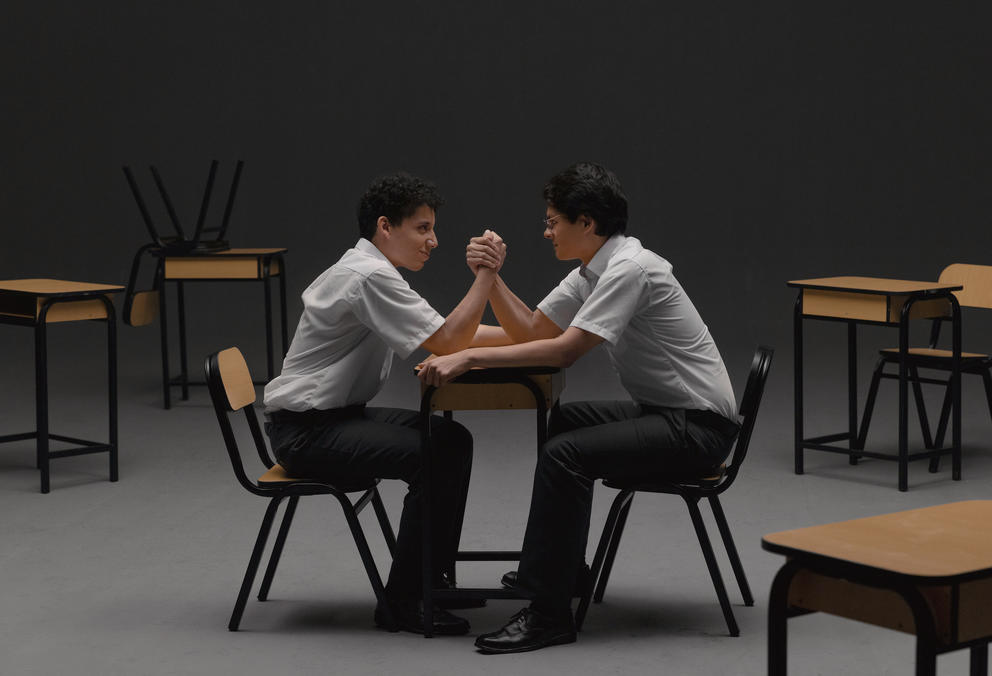Many such questions surface and linger in Soft Boy, Soldi’s evocative new exhibit at Frye Art Museum (through Jan. 7, 2024).
The show is composed of three distinct sections, one of which is the video installation (also titled Soft Boy). It’s the first time the Seattle-based artist, best known for his photography, has made the leap to the moving image — and it is moving on several levels.
Projected across three tall screens that immerse the viewer, the looping video reveals one, two, then 10 young men wearing identical school uniforms. In a series of non-narrative vignettes staged in a blank-slate studio, they engage in various shows of masculinity: playing soccer, roughhousing, arm wrestling and marching in formation.
Throughout, their actions tread a fine line between cruelty and intimacy, torture and pleasure. It’s the dissonance and uncertainty around that line that Soldi explores in Soft Boy — which is based on his memories as a queer youth.
“It charts my relationship to my childhood growing up in Peru, attending an all-boys Catholic school and navigating masculinity, the different ways in which we were taught to be men as young boys,” he told Crosscut Now.
Having immigrated to the U.S. in 2003, Soldi believes there’s “an epidemic of isolation between men across the world,” which he believes is why “we create these violent rituals to find ways to become close to each other.”
Soldi spent five years making the film, returning to Peru to seek out the young men who would serve as stand-ins for his fuzzy recollections. Before filming, he and the boys — half of them queer, half straight — spent time talking about all kinds of male relationships and the “theatrics” of masculinity.
“They shared a great deal about their own experiences with their fathers, with school, with their peers, with their own identities,” Soldi said. When the camera started rolling, the boys improvised, pulling from their own lived experiences and using prompts Soldi drew from his school days.
The new film is an outgrowth of another element in the show, a series of four large black-and-white prints titled CARGAMONTÓN. The title is the name of a “pig pile” game Soldi played in his youth. In the Peruvian dialect it translates to “the harassment of one by many,” Soldi explained. “So it’s pretty straightforward … it was a way of humiliating someone.”
Soldi says he remembers being the boy at the bottom of those piles, feeling both terrified by the brutality and thrilled by the closeness.
Several years ago, when he started looking for evidence of the hazing rituals that flickered in his recollections, he found YouTube videos posted by Latin American boys playing the same games in the early 2000s. “I was very surprised to find that footage online and to go back in time and relive some of those moments,” Soldi said, emphasizing that the discovery was “emotionally complicated.”
Soldi took screen grabs from the videos by photographing his laptop — adding layers of distance between himself and the experience. Then he drew closer, converting the blurry screen grabs into large-scale images using a 19th-century printing technique called photogravure. He worked with masters of the form in Mexico City to etch the images into copper plates, which were then inked and printed.
The result is a set of freeze-frame images that are both hyper-present and abstracted, like so many childhood memories. Looking at them on the wall, it’s hard to tell whether the boys involved are enjoying the schoolyard rituals or are frightened by them.
Mixed messages also come into play in the third section of Soldi’s exhibit, mouth to mouth. Here, Soldi presents 83 softly hand-lettered words in Spanish and English, framed and deliberately positioned to highlight resonances between the languages.
Requiring you to step closer to read them, the word pairings become another game, another form of intimacy.
Soldi points to his own misunderstandings as he tried to learn English, as well as connections you might not see if you aren’t bilingual: “Sí, Sí” (“Yes, Yes”) next to “Sissy,” for example. Because of his sense of feeling “orphaned” at times by both languages, he worked with the Frye to ensure all descriptive text is in both English and Spanish.
Despite the deeply personal source of the artwork in Soft Boy, Soldi says he hopes his reach is much wider.
“I’m not interested in someone coming to the museum to learn about my life,” Soldi says, “I’m interested in having broader conversations about … how we can learn to talk about these very complex issues.”
Get the latest in local arts and culture
This weekly newsletter brings arts news and cultural events straight to your inbox.




